Red Fox Dens/Earths & Resting Sites
Foxes sometimes take up residence underground in excavations called earths or dens – these terms are used interchangeably, although earth tends to be a British term, while den is more commonly used in American and European literature. In some early, particularly hunting, literature an earth is occasionally referred to as a "kennel" or "lair". At its most simplistic, an earth is a hole dug into the ground, with a hollowed-out chamber at the end of the entrance tunnel where the fox sleeps and in which cubs are raised. The chambers are typically between one and three metres (3–10 ft.) below ground, with tunnels generally leading to more than one entrance (a main entrance and emergency exit); in his Walker’s Carnivores of the World, Ronald Nowak gives the largest number of entrances for a single earth as 19. The entrance tunnel is typically between five and seven metres (16–23 ft.), although they may reach up to 17 m long (56 ft.).
According to Vladimir Heptner and Nikolai Naoumov, in their 1988 Mammals of the Soviet Union, foxes dig downwards at an angle of 40 to 45-degrees, creating tunnels 15 to 20 cm (8 in.) in height and 25 to 30 cm (12 in.) wide, depending on the soil type; entrances are oval or rounded, 30 to 40 cm (16 in.) wide and up to 70 cm (2 ft. 4 in.) tall. In some instances there may be more than one earth within a territory: smaller ‘standard’ earths used for resting and a larger ‘natal’ earth in which the cubs are born and raised. A characteristic of earths is a lack of bedding (unlike badgers that periodically bring fresh vegetation back to the sett, foxes do not use bedding material); they may also mark the entrance with scat. An earth may be used for several consecutive years.
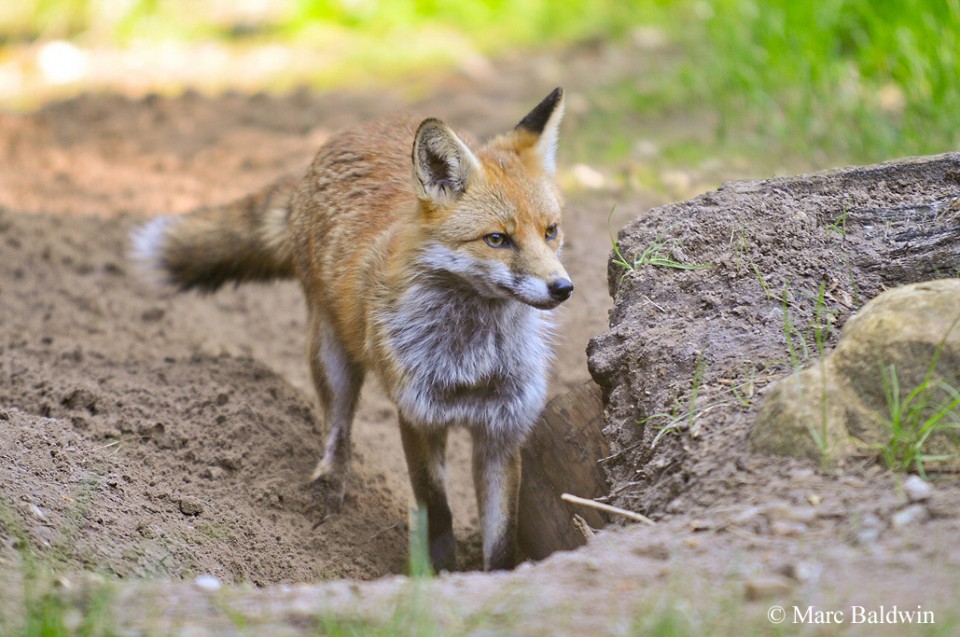
Suitable earths are an important resource for foxes and a recent survey in Germany concluded that the availability of suitable territories, containing convenient breeding dens, was a crucial factor limiting the country’s fox population. Consequently, foxes tend to be less ‘picky’ about the type of places they use as den sites than some other animals. A study published in the Southwestern Naturalist back in 2000 found that Swift fox (Vulpes velox) earths on the Great Plains of North America were pretty much identical with respect to size, number, direction and shape of openings, distance between openings, dimensions of tailings, slope of site, surface roughness and ruggedness of site, surrounding vegetation and soil type. This suggests that foxes seem to be capable of exploiting resources in most available habitats, although there are some features that foxes seem to look for when selecting an earth or potential earth site.
Preferred den sites tend to be on sheltered (among trees, under buildings or under dense vegetation such as bramble), well-drained ground (often slopes) with loose, easily dug, soil. In a study of fox populations in Hakel, eastern Germany, Michael Stubbe found that 95% of the 145 earths he looked at were on south east-facing slopes, which had an average inclination of 20-30 degrees. Sometimes habitat preferences are also apparent and a study of foxes in Tuscany, Central Italy, found they showed a preference for marquis (scrubwood), meadows and pine forests in which to create earths, with the former being most (and latter least) used during cold seasons.
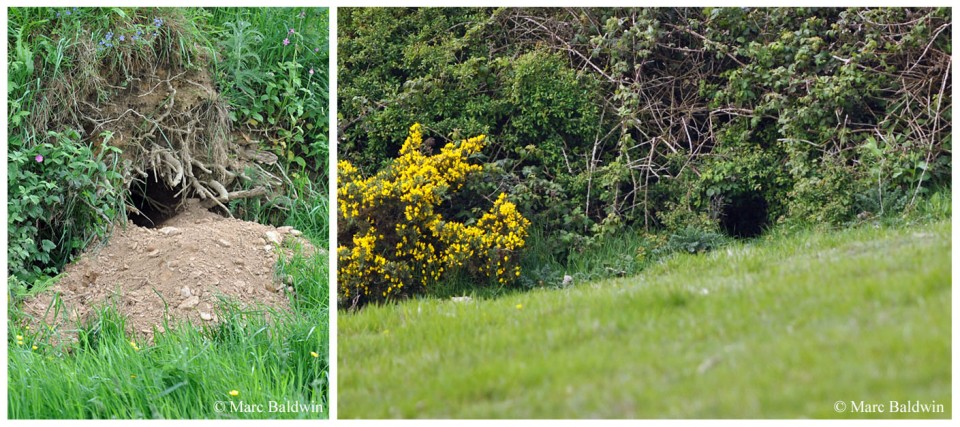
Foxes tend to tolerate more human disturbance than many other mammals. In a study of fox and badger dens in the Kampinos National Park, central Poland, botanist Przemyslaw Kurek found that foxes showed no particular preference for the placement of their earths, settling significantly closer to urban areas than badgers. Kurek suggested that there are two reasons behind this settlement pattern: in the first instance foxes lived at higher densities within the reserve than badgers, so they may not have the luxury of choice; secondly, foxes are generally much less “anthrophobic” (i.e. scared of people) than badgers. Consequently, foxes have little problem finding suitable den sites in our towns and cities.
City living foxes
Urban foxes will readily make dens in all sorts of places. In their 2001 book Urban Foxes, Stephen Harris and Phil Baker describe various examples, including foxes raising cubs in the false ceiling of an architect’s office, under the kitchen floor of an occupied house (the adults were apparently frequently chased down the hallway by the family’s dog), and another similar example in which the foxes chewed through gas pipes causing a major gas leak.
There are various reports of foxes raising cubs under the floorboards of classrooms and in the 54,000-seater Yankee Stadium in New York. In his Running with the Fox, David Macdonald described how, in the late 1970s, a vixen burrowed into the earth mound above an underground chamber housing Oxford University’s seismograph, causing it to register a series of spurious earthquakes. As endearing as it may sound to some to have a littler of cubs under your floorboards, they can be a considerable nuisance. Harris and Baker describe the chewing of electrical cables, the noise made by cubs playing under the floor throughout the night; not to mention the smells, dust, etc.
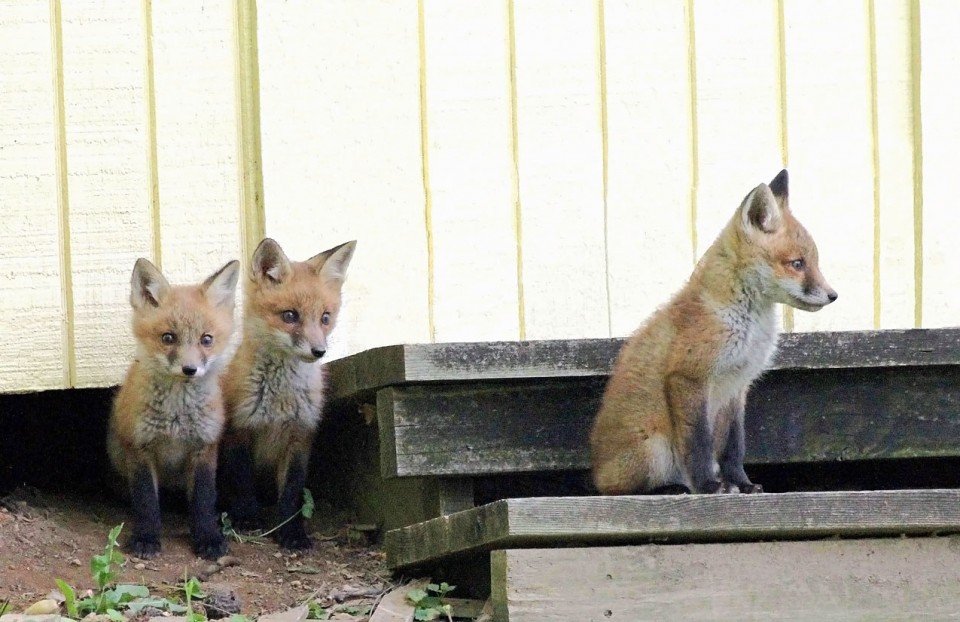
While it is fairly common for foxes to raise cubs in disused (or rarely used) buildings, examples of them denning in occupied houses are rare. Ordinarily, urban foxes confine their activities to our gardens and arguably the most popular urban earth sites are under garden sheds. A study in Bristol city found 37% of earths were under sheds; other studies found around 15% in Oxford city and 25% in an area of London were similarly located. In Melbourne, Australia, Clive Marks and Tim Bloomfield found that 44% of earths were dug under buildings and out-houses, while a survey of foxes in Germany found about 12% of breeding dens were associated with buildings. Other locations in urban settings include earths dug into rockeries, earth banks (31% in Marks and Bloofield’s Melbourne fox population) including railway embankments, flowerbeds, under gravestones in cemeteries, and among tree roots. In fact, foxes don’t always stop at the base of the tree and people have been, justifiably, surprised to find foxes in trees.
Highrise living
Unlike Gray foxes and cats, Red foxes don’t have much rotation in their forearms and so cannot climb trees in the same way (i.e. grasping both sides of the trunk and pushing up with their hind legs); this limits them to trees with low branches on to which they can jump, or with shallow-sloping trunks. Regardless, foxes will often climb trees to search for food (birds, eggs, fruit, etc.), escape flooding, or simply to rest in the sunshine, but in some rare cases they have been known to make arboreal dens. Indeed, in Urban Foxes Harris and Baker wrote:

"In one instance, in a cemetery in Bristol, an evergreen oak had been extensively pruned and shaped, and all the cut twigs and leaves had accumulated in the crown of the tree to form an impenetrable mass amongst the branches. The vixen had climbed into the tree and dug an extensive burrow system amongst the compacted prunings. Here she gave birth to her cubs for several years running, only moving them out of the tree once they were big enough to play."
More recently, a family of four foxes made the British press when they made what appeared to be an earth nine metres (30 ft.) up a tree in a back garden in Ipswich, Suffolk during January 2009.
Despite these sporadic reports, it is rare for foxes to construct their earths in trees. It is not, however, uncommon for them to be found resting on branches during the day and, in June 2020, I saw a photo of a fox snoozing at the top of a 4.6m (15 ft.) leylandii hedge on the Isle of Wight. Additionally, in his 1968 book Town Fox, Country Fox, Brian Vezey-Fitzgerald told how:
“Shropshire foxes are said to be particularly prone to lying-up in trees – on one occasion three were dislodged from the same tree…”
Foxes will also climb on to building roofs both to rest and search for prey. In a 2004 paper to Western North American Naturalist, James Sedgwick and John Bartholomew documented just such behaviour; they observed two young foxes 9.5m (31 ft) above ground on the roof of a domestic animal building in Fort Collins, Colorado. Outside of the city, foxes will often take over the disused burrows of other animals (especially rabbit burrows, which they extend to suit their size) or use existing structures such as rock caves, scree piles, wood piles, etc.
To dig or not to dig?
In a survey of fox earths in various habitats around Saarbrücken in western Germany, Darius Weber found that foxes dug 44% of the earths themselves, with the rest either being the work of other animals, or situated in bunkers, caves or craters. In this study, the foxes frequently used rabbit burrows or badger setts; the use of the latter by foxes has been well documented in Britain and Europe. In their 2000 paper to Wildlife Research, CSIRO biologist Robyn Molsher and her colleagues note that foxes frequently use active rabbit warrens as dens for the birth and caring of cubs.
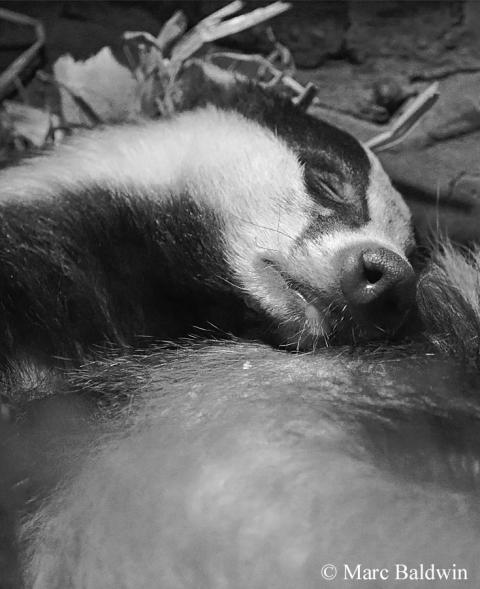
There is much in the literature about the cleanliness, or more specifically the lack of cleanliness, of fox earth and Brian Vezey-Fitzgerald, in his 1968 Town Fox, Country Fox, points out it is widely reputed that badgers will vacate setts if a fox moves in, because they cannot put up with the smell or mess that the latter make. Curiously, in his book My Life With Foxes, Eric Ashby notes that his foxes kept their breeding earths very clean and that the cub he hand-reared never once soiled her bed. Ashby writes:
"Foxes' instincts towards their homes are dominated by attention to detail and by an overwhelming concern for cleanliness. Tessa [a breeding vixen] kept ber cubs and their den spotless. As little as two weeks after the birth, we had seen Tessa move three cubs outside the box so that she could scrape at and re-arrange the wood shavings, before taking them back in to join the others."
Returning to Vezey-Fitzgerald's point; badgers may move out in some cases, but there are a considerable number of examples where the two species have shared (albeit different parts of) the same sett over successive generations. In their 1996 book, Badgers, Ernest Neal and Chris Cheeseman note that, although foxes occasionally dig their own dens they are typically "lazy diggers and much prefer to use badger setts if available". Moreover, Neal and Cheeseman point out that, in the Netherlands, Switzerland Denmark and Germany, "it is the rule for foxes and badgers to live in the same sett" – it has been postulated that this reflects a lack of suitable habitat in these countries. Similarly, in his 2010 book Badgers, Timothy Roper suggests that the increase in foxes observed during a badger culling trial may have been a response to an increase in the number of suitable vacant setts in which the foxes could raise their cubs. That said, Roper does note that:
“Badgers and foxes are more tolerant of one another than is sometimes assumed, and it is not unusual for a large main sett to contain breeding females of both species.”
This relationship seems to work well and the badgers -- despite apparently being the dominant residents (they can apparently evict foxes at will) -- tolerate foxes for most of the year. The situation can, however, change when cubs are present. Intriguingly, whoever has cubs seems to get movement rights. One example of this comes from a wildlife park in Avon, where expansion of an earth by foxes had caused the amalgamation of the foxes' earth and a nearby badger sett. In this case, foxes were only dominant when they had cubs. When badgers have cubs underground, any encroachment by a fox typically meets with strong aggression on the part of the sow.
The construction of earths by foxes can affect other species in the vicinity and Polish botanist Artur Obidzinski has spent much of his time looking at how fox earths change the local ground flora. In a 2006 paper to Polish Botanical Studies, Obidzinski and colleague Piotr Kieltyk reported that the presence of fox earths caused local changes in the composition of the herb layer, limiting the development of plants by burying their above-ground parts, damaging root systems and trampling leaves. Uneaten food left lying around by the earth’s inhabitants was found to increase soil fertility and pH (i.e. make it less acidic) and foxes moved in seeds on their fur and in their scat; they also activated dormant seeds while digging. Overall, Obidzinski and Kieltyk found more plant species in the vicinity of the earths than the surrounding, undisturbed, area.
Anyone home?
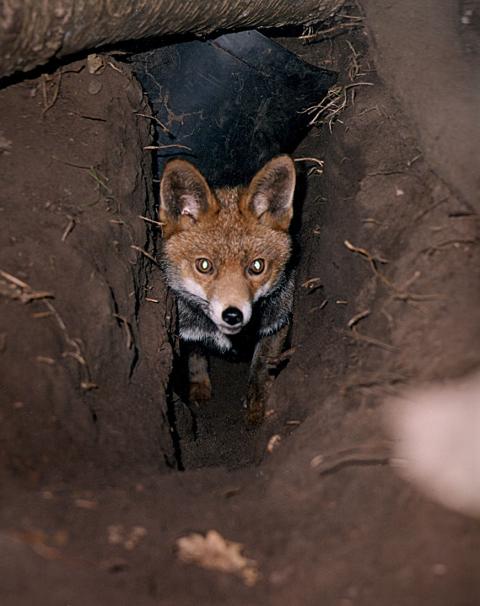
How intensively an earth is used will depend on the season, habitat and the individual fox. In most cases, foxes tend to use earths only while rearing cubs or during particularly bad weather (i.e. heavy snowfall). In his chapter on the Red fox in the 1970 BBC book Private Lives: Studies of birds and other animals, Roger Burrows noted a difference in den use between the sexes, with vixens spending much of the winter in the ‘relative comfort’ of the earth, while dogs seldom, if ever, used earths, preferring instead to lie-up above ground.
Studies on Bristol’s foxes have shown that males very rarely use an earth; normally it is only inhabited by the vixen and cubs, such that the dog’s first contact with his offspring is when they emerge from the den at around four weeks old. The vixen and cubs use the earth for around four months, after which the foxes tend to spend most of their time lying up in nearby vegetation during the day. Indeed, for most of the year, foxes seem to prefer to lie-up in vegetation, rather than using an earth and, in urban Melbourne, Marks and Bloomfield found that almost 80% of resting periods were spent sheltering in exotic weed infestations (blackberry, fennel, thistle, etc.). It seems that, along with harsh weather conditions, the amount of available cover also determines how likely a fox is to use an earth.
Between September 1989 and February 1992, Jean-Steve Meia and Jean-Marc Weber at the Université de Neuchâtel in Switzerland radio-tracked seven adult female foxes in the Swiss Jura Mountains. Their results, published in the journal Acta Theriologica during 1993, showed that the foxes seldom rested at a den site during the night (only 1% of observed resting periods were in dens), opting instead to lie-up in cover -- such that they were hidden -- close to where they had been active. During the day, however, three females frequently used dens, while the remaining four seldom used them. One vixen raised cubs during the study and was located in an earth during this time, but spent the majority of her time outside the cubbing season resting above ground.
Sleeping under the stars
Interestingly, Meia and Weber found a positive correlation between the amount of open ground and the time spent resting in an earth, suggesting that foxes may use earths more often in habitats with little or no secure cover. The foxes also used only a few of the dens within their home range and there was no relationship between the number of earths in the territory and the number used by the territory holder.
Interestingly, Meia and Weber also found that weather (with the exception of extreme weather, notably snow) didn’t influence whether the foxes used an earth. In 1989, French biologist Marc Artois suggested that foxes avoided rain because it upsets their insulation (wet fur sticks together and is a very poor insulator) and both Stephen Harris and Huw Lloyd have noted that foxes prefer to lie in earths during bad weather. Meia and Weber, however, often observed foxes resting in totally open areas in heavy rain during the night. I too have seen a fox resting by a hedge, seemingly unconcerned by the rain and have watched foxes hunt during heavy rain and falling snow. Finally, this Swiss study noted that foxes often moved from one surface resting site to another for no apparent reason (i.e. weren’t disturbed) – given that resting and den sites were often situated at the periphery of the home range, the authors suggest that this may be the foxes resting as they patrolled their territory.
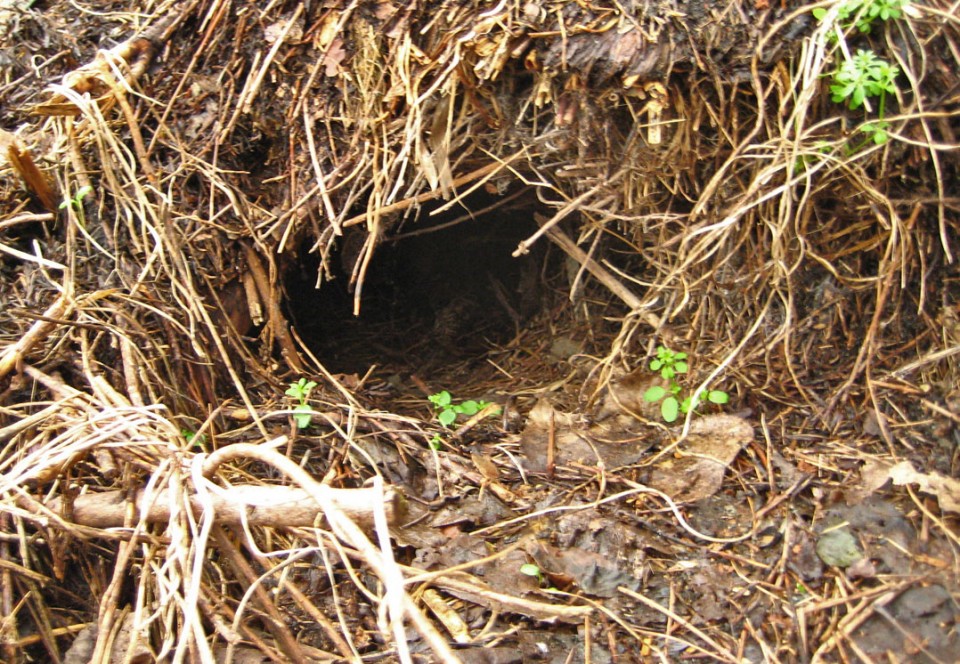
Ordinarily, foxes will seek out favoured sites within their territory that provide secure cover (high cereal crops or grass, reed beds, bramble, bracken, etc.) in which to rest, but they will also hollow out temporary resting sites in some unexpected places. I have seen photos of a fox ‘rest’ dug into a compost heap (I presume the decomposing vegetation provided a valuable source of warmth and insect prey), another in a large haystack and also a pair of foxes lying among the ashes of a bonfire during very cold weather. In areas of high disturbance or where foxes are heavily persecuted they will often opt for resting sites that provide a good view of approaching danger and, in urban areas, such places tend to be shed roofs, but boulder scree is popular among hill foxes.
Between January and May 1990, Ray Hewson studied the use of earths by two young vixens living in the hills of north-west Scotland. He found that they showed a preference for resting sites at a high vantage point with a good view of the surrounding area and where the foxes could move in and out of the earth under the cover of boulders. Similarly, in Cumbria, David Macdonald found that most daytime resting sites of foxes were in boulder scree, from where they had a good view of their surroundings; a minority were in peat holes, in which it was difficult for them to spot people sneaking up.
In a recent study of space use by foxes in the southern German district of Starnberg, Christof Janko and colleagues at the Technische Universität München found that they used up to 10 resting sites situated throughout their home range; almost two-thirds (62%) were located in forests, while 21% were in reed beds and 15% were in gardens. The researchers found no significant difference in the resting sites chosen by males and those chosen by females.
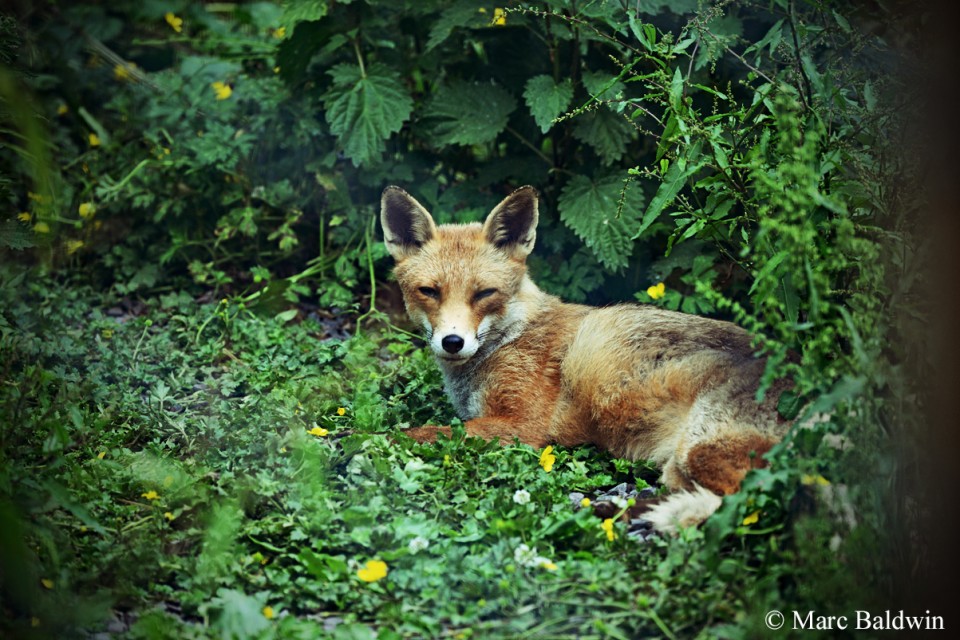
There is some suggestion that foxes show a preference for certain ‘directions of resting’, associated with how deeply they’re sleeping. In a curious paper to Behavioural Processes during 1979, Günter Tembrock described the choice of resting side in a group of 15 captive foxes, finding that:
“… the preferred direction of the resting position (curled up to the right or to the left) is not accidental. For all foxes considered, the preference for the left position is significant.”
In fact, when the group was split up according to sex, it transpires that only the males showed a statistically significant preference for resting side. Moreover, dominant males were significantly more likely to lie on their left-hand side than subordinate animals and this preference seemed to develop at around seven months old. Tembrock suggested that foxes were more alert when lying on their left side of their body (i.e. they could react quicker to an approach) than when on their right side, although why that should be so is unclear.
Rip Van Reynard?
Whether resting on their right or left, there are several stories attesting to just how deeply foxes can sleep. During his studies in Bristol, Carl Soulsbury noticed that the signal from one fox hadn’t moved for eight hours and, the following day, he went to recover what he thought was the fox’s body, only to find a very much alive animal apparently aggrieved at being woken up. I know several photographers that have stumbled across a sleeping fox that hasn’t been woken by several minutes of photo-taking.
While sleeping, it has been suggested that foxes take comparatively few breaths and, in his book Wild Fox, Roger Burrows recounts how, on 29th February 1964 at 4pm, naturalist Trevor Walsh happened upon a fox curled up asleep on the Cotswolds, near Stroud. Mr Walsh watched the fox and counted 12 breaths in five minutes; this is an average of 2.4 breaths per minute (brpm) or one breath every 25 seconds. According to Burrows, this compares to around 10 per minute for a sleeping human or domestic dog (one every 6 seconds), suggesting either that foxes have a more efficient oxygen extraction mechanism, or they can lower their metabolism further than either dogs or humans.
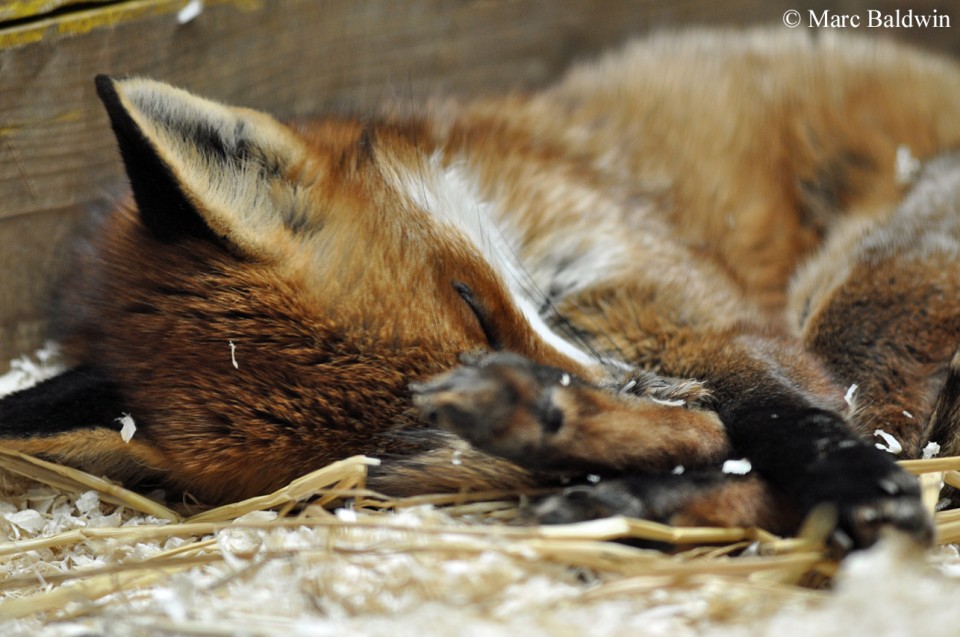
Walsh’s estimate seems very low and one is driven to wonder whether some breaths were missed, or whether (as with much else in his book) the account was misinterpreted by Burrows. Certainly, the scant literature on the subject would seem to imply this was so. In a paper to the Canadian Journal of Zoology in 1989, Terry Kreeger and colleagues reported 16-20 breaths per minute in their sleeping foxes, along with a heart rate of about about 90 beats per minute (bpm); females having a faster sleeping heart rate than males. Recent contact from readers suggests that even 16-20 brpm may be low.
In June 2015 I was contacted by Ingo Rieger, a Swiss behaviourist who offers advice on animal husbandry. Ingo was surprised by the low breathing rate referenced by Burrows and asked one of his friends to count the breaths per minute of their hand-reared pet fox. The result, while the fox was sleeping on a sleeping bag with its owner, was 27-29 brpm, or one breath every two to 2.5 seconds - much higher than Walsh's count. Similarly, while watching a vixen asleep on their decking in Colorado (USA) a reader counted the breaths per minute against a stop watch over two consecutive one-minute intervals; the first was 22 brpm, the second 23 brpm. I would be interested to hear from any other readers with pet foxes on how often they breath during their sleep.
Finally, Kreeger and his team reported heart rates of about 125 bpm while resting, 175 bpm during a hunt and 300-400 bpm while running or being chased. Their body temperature hovers around 40C (104F).
No place like bed
Although dog foxes rarely use earths, vixens may occasionally share them with other females, either simultaneously or asynchronously (i.e. use the same earth or rest site at different times). David Macdonald, in his 1987 Running with the Fox, described how a vixen regularly used the same earth throughout the winter, occasionally sharing it with one or two other vixens. Burrows considered that vixens lie up underground from November to March, possibly sharing an earth, while Meia and Weber observed that several individuals used the same resting sites, although they don’t say whether they did so at the same time. During his study of hill foxes, Hewson found that the two vixens had their own ‘exclusive’ resting sites as well as those that they shared with each other, although rarely on the same day. It has been suggested that much of the social interaction between members of a fox group occurs at resting sites, so it is presumed that any sharing of earths or rest sites is between family members.
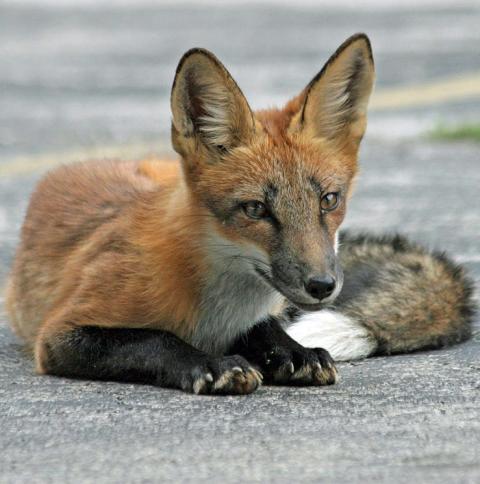
Finally, it is worth making a brief mention of rest site fidelity – that is, how ‘faithful’ foxes are to a given spot. In a 2003 paper to Acta Theriologica, a team of biologists at Bristol University -- led by Tabetha Newman -- presented their analysis of resting site fidelity among foxes in the north-west of the city, before and after the outbreak of mange that decimated the fox population during the mid-1990s (i.e. comparing high and low population densities).
The researchers looked at radio-tracking data and found two major shifts associated with the dramatic decline in fox numbers: they were less faithful to rest sites, and they chose different areas in which to rest. Before mange arrived a fox would spend 80% of its inactive time at a regular rest site, being found in a single ‘favourite’ site about half the time. Once the population had crashed, the researchers found them at regular rest sites only 15% of the time and, of this time, just under 20% of ‘fixes’ were at a single favoured site.
In the pre-mange years, foxes spent most of their time resting in back gardens (particularly under sheds), with allotments, woodland and grassland coming in joint second. In the post-mange years, however, foxes seldom chose to rest in gardens (rarely being found near a shed), much preferring allotments or woodland – they opted to rest in badger setts or thick patches of bramble. The biologists suggest that when the fox population was high, foxes were forced to rest in the same site frequently and in locations that may not be their first choice because space was at a premium; when numbers dropped, foxes were free to rest where they wanted. Changing rest sites more frequently may also have helped the remaining foxes control parasites, such as the mange mite.